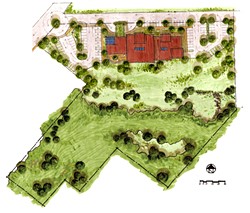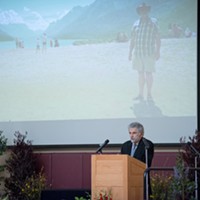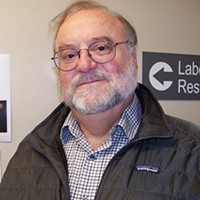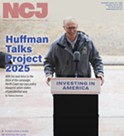The $10 Million Dash
Open Door has two years to build a new health center, or its ObamaCare windfall disappears
By Ryan Burns [email protected] @RyanBurnsy[
{
"name": "Top Stories Video Pair",
"insertPoint": "7",
"component": "17087298",
"parentWrapperClass": "fdn-ads-inline-content-block",
"requiredCountToDisplay": "1"
}
]
Hermann Spetzler's accent is hard to place. A stately man of 62 with a beard gone mostly gray, a head gone mostly bald and sprightly eyes behind wire-rim glasses, Spetzler speaks in a warm tenor that curls around "r"s and nestles between sharp consonants. Like Spetzler himself, the accent was born in Germany and spent its formative years in the American Midwest. It was further flavored (or made "weird," in his own estimation) when at age 19 Spetzler briefly returned to his home country to study as an interpreter. His Irish instructor adhered strictly to the Queen's English and insisted Spetzler do the same. The resulting voice is deep, calm and inexplicably similar to the late Puerto Rican actor Raul Julia's.
For nearly 35 years now, his has been the voice of Open Door Community Health Centers (ODCHC), an endeavor born as a wide-ranging egalitarian movement among late-’60s Arcata hippies that has evolved into a modern network of nonprofit health care facilities serving some 50,000 patients across a region the size of Connecticut. As CEO, Spetzler has helped guide the organization through drastic changes in the health care landscape, both locally and nationally. As the community's needs have grown, so too has ODCHC, establishing new clinics in Crescent City, Willow Creek, McKinleyville and Eureka and expanding services to include dental care, prenatal and birth services, pediatrics, telemedicine and much more.
The organization has now embarked on an ambitious new effort that, if successful, will represent its most dramatic transformation to date. Two months ago, ODCHC executives, including Spetzler, learned that their organization had been awarded a federal grant of nearly $10 million. This grant, made possible through President Obama's Affordable Care Act, will allow them to build a new, state-of-the-art health center in Eureka, something they desperately need. Competition for the grants had been fierce; just 183 were awarded nationwide to a pool of more than 800 eager applicants. ODCHC's $9.8 million award was the 18th largest in the nation and the second largest in the state. "It's like a gift from the gods," Spetzler enthused.
And it's arriving none too soon. For years the Eureka clinic has been bursting at the seams, squeezed into a shoebox of a building in the medical suburbs of east Buhne Street. (In its grant application, ODCHC described the 1950s-era building as "maze-like, ADA non-compliant [and] in need of constant update.") The supply of primary care physicians on the North Coast has been dwindling, and the clinic's waiting list has swelled to as long as eight weeks for non-emergencies, leading many patients to seek care from the Arcata and McKinleyville clinics (which aren't much better off) -- or, worse, to forgo planned visits altogether. A big new clinic is just what the doctor ordered.
However, the grant comes with a big "if" attached: If ODCHC can't complete the project within two years, the money vanishes. That means a site must be located and purchased; designs must be drawn up; environmental impact reports written and approved; contracts put out to bid; inspections performed; permits granted; construction completed; new staff hired and trained. And if anything goes wrong, if it even looks like ODCHC won't get the clinic's doors opened by Sept. 30, 2012, then the feds take their money back.
Spetzler characterized this predicament with deadpan humor: "We have to get it done in two years," he said. "Otherwise it turns into a pumpkin."
At the Eureka City Council meeting held Nov. 2 -- Election Day -- Spetzler stood at the podium, his broad shoulders squared to the council, and explained the challenges posed by ODCHC's tenuous windfall. "What we got along with the grant is a timetable that was clearly developed by bureaucrats who have never built anything themselves," he said. The key to meeting the fast-approaching deadline, he said, is finding the right location, which, with the assistance of city staff, he believed he had: 7.25 vacant acres on the Eureka waterfront known as the Halvorsen site. Owned by the Eureka Redevelopment Agency, this patch of rocky, weed-strewn ground -- a former mill site just west of the Samoa Bridge -- has at various times been slated for a Hampton Suites hotel, an eco-hostel and, most recently, a convention and visitors' center.
But while Spetzler seemed convinced of the Halvorsen site's suitability, several councilmembers -- namely Mike Jones, Jeff Leonard and (now Mayor-elect) Frank Jager -- were skeptical. "It's pretty much the number-one piece of open property in the City of Eureka," Leonard cautioned. As such, they suggested, shouldn't it be reserved for something tourism-related?
Spetzler held firm in his convictions and equivocated when Jones asked -- twice -- if ODCHC could simply stick with the site it had previously identified on Tydd Street, a little dead-end road that cuts behind the CVS pharmacy on Myrtle Avenue. "For me," Spetzler responded carefully, "the biggest fear is that the $10 million would go away, and that would be really difficult."
And yet, in a surprising turnaround, Spetzler returned to the council two weeks later and announced that Open Door would abandon the Halvorsen site after all, and return to Tydd Street. Community Development Department Director Sidnie Olson later told the Journal that she didn't know why Spetzler changed his mind. "The Halvorsen site would have been substantially less challenging," she said in a phone conversation last week. The Tydd Street location faces at least three major issues that aren't present on the waterfront property, she said: a traffic quagmire, possible insufficient water volume/pressure for fire safety and coastal resource protection issues. (The Tydd site abuts protected wetlands, while Halvorsen is set back from the bay by a pedestrian walkway).
In a phone conversation last month, Spetzler explained that his reversal was at least partially motivated by what happened on Nov. 2 -- not inside council chambers but in local ballot boxes. On Election Day, a slate of developer-friendly candidates was swept into office, and that made Spetzler nervous. "I just got the feeling ... that somewhere in the middle of the project somebody could have pulled out -- or [come up with] some reason why they needed to take more time and do more research -- and potentially scuttled everything."
Spetzler added that the Halvorsen site had unforeseen issues (including ownership restrictions dictated by terms of an EPA cleanup grant for the property), and at any rate, he insisted that he's perfectly happy with the Tydd Street site. As the turnaround spot for all Eureka bus lines it will be accessible to all local residents; it's adjacent to the Silvercrest senior housing development, which is convenient for those residents; and, best of all, the property offers an unobstructed view of the Humboldt Bay wetlands.
The site is actually three parcels (one owned by the Eureka Redevelopment Agency, the others by local developers Brendan McKenny and Larry DeBeni) and the zoning is split between service-commercial and multi-family. But Olson came up with a clever way to sidestep much of the red tape: She realized the City could simply classify the new health center as a "charitable institution" rather than a medical office. She's now confident that city staff can provide the necessary permits in the time allotted. "It's a good location for what they want to do," she said.
At its Nov. 16 meeting, the Eureka City Council voted unanimously to pursue a deal with ODCHC for the Tydd Street site. And thus the first hurdle -- finding a location -- has been cleared. And the time-line is down to one year, nine months and change.
Open Door first opened its doors as a clinic in 1971 in what's now the Tin Can Mailman bookstore on the corner of 10th and H streets in Arcata. The storefront had previously been a branch of the Bank of Italy (later to become Bank of America), and renovating the place -- which required jackhammering out the vault, removing the twisted rebar pillars and suspending a second floor from the ceiling -- took a year. By the late-’70s it was already running out of room, starting a pattern that continues to this day. By 1984 they'd moved next door into a former funeral parlor, where the Arcata clinic remains. In the early ’90s it added clinics in Eureka and Crescent City, and as it's expanded it's also modernized. Through their telemedicine center they provide services to more than 20 other clinics throughout the state and beyond, and via the same technology North Coast patients can consult with specialists from UC Davis, UCLA or other "centers of excellence."
This may sound like a perfect example of robust entrepreneurial growth, and in a sense it is. But the big picture is far more troublesome -- growth isn't always a sign of health. ODCHC has found it necessary to expand and diversify in large part because America's health care industry has steadily mutated and metastasized, infected with parasites of the insurance and pharmaceutical genera. "We interact with the health care system so episodically that we don't realize how broken it really is," Spetzler told the Eureka City Council.
Last week, Dr. James T. Hay, a family physician in Encinitas and president-elect of the California Medical Association, came to Humboldt County as part of a statewide checkup of regional health care. He was joined at a press conference by three other physicians -- surgeon Luther Cobb, a CMA officer and the next chief of staff at Mad River Community Hospital; Dr. Mark Ellis, a local pediatrician and president-elect of the Humboldt-Del Norte County Medical Society; and Dr. Kate McCaffrey, a family practice and neuromusculoskeletal doctor in McKinleyville. What's unusual about this sampling of doctors is that three of the four are primary care physicians, a vocation that's becoming less and less common.
In decades past, new doctors could simply hang up a sign and start a practice. But as health care has grown increasingly complex -- and spawned bureaucratic support industries of questionable value -- med school students face strong incentives to become specialists. "It's really common for students finishing up their medical training to have $250,000 or more in debt," Cobb said. The comparatively low salaries offered to family practice doctors dissuades students from pursuing that traditional path. "And that's tragic," Cobb said. "Primary care is the foundation for all the medical field."
Making matters worse, area doctors are retiring in droves. In recent years, at least 25 percent of primary care providers and specialists have retired or relocated, with few replacements, according to data provided by the Humboldt-Del Norte Medical Society. The average age of Humboldt County physicians is now 55. And according to Hay, most younger doctors aren't willing to put in the 80-100 hours per week that previous generations worked. "The population's growing, and we're seeing a decrease in productivity," he said. "It's going to be a major problem."
Here on the North Coast we face challenges above and beyond the shortage in doctors. With relatively high unemployment and poverty rates, many adults and children lack health insurance, almost 40 percent of low-income adults and 13 percent of all children in Humboldt County, according to a recent report by the California Center for Rural Policy. The report also found that low-income families are significantly receive routine check-ups, regular dental care or diabetes screenings. Not surprisingly, given these conditions, the North Coast has more deaths due to all causes and more premature deaths per capita than the state average. (See "Hazardous to Your Health," Nov. 11).
While the Affordable Care Act was intended to alleviate just such problems, the panel of doctors at last week's conference remain concerned, particularly for patients on Medicare, Medi-Cal or both (or neither, for that matter). Medicare reimbursements for doctors have not kept pace with the rising cost of care. Consequently, doctors who accept Medicare patients are set to see a 25 percent cut to reimbursement rates as of Jan. 1. According to Hay, this would lead many doctors to stop seeing Medicare patients. Medi-Cal, on the other hand, will benefit from reimbursement increases for some services thanks to the ACA, but because of state budget problems there will be reimbursement cuts for other services, including vision and dental care, Hay said. And people who have both -- called "Medi-Medis" -- may be subject to higher out-of-pocket requirements currently being proposed in Washington, D.C.
McCaffrey said these developments have particular significance on the North Coast because of our poor, rural demographics. "My practice is 46 percent Medicare, 11 percent Medi-Cal and five percent uninsured," she said. "So the laws we're talking about nationally and statewide hit hardest in our area."
Enter the new Open Door Health Center. In a recent meeting with the Journal at ODCHC's executive offices, overlooking the Arcata Plaza from above Jitter Bean Coffee, Spetzler and ODCHC Development Director Chris Peters said the new clinic will not only help patients in Eureka, it will also serve as a pressure release for Arcata and McKinleyville. "Sixty percent of our Eureka patients receive their health care in Arcata [or] north," Spetzler said. The new facility will allow ODCHC to double its Eureka staff -- from 50 to 100 -- and the clinic itself will be more than twice as large, in excess of 26,000 square feet, compared to the 10,000 square feet of the current Eureka clinic and telemedicine center combined.
What earned ODCHC the $9.8 million grant that will make all this possible was not merely need, though that certainly played a role. "We're really competing with an overwhelming need in the whole nation ... ," Spetzler said. "What makes our proposal special, I think, is that it's not just about a health care facility, but it's about a green health care facility."
Sustainable design was an explicit criterion of the grant application, and ODCHC swung for the fences. By incorporating such earth-friendly features as permeable paving materials, rainwater collection for irrigation, photovoltaic solar arrays and a vegetated roof (to alleviate the "heat island" effect of urban buildings), the clinic has been designed to achieve the latest LEED (Leadership in Energy and Environmental Design) certification. "It will be an attraction in its own right equal to the Arcata Marsh," Spetzler boasted. "There will be people for the next 10, 15, maybe 20 years who will look at that end product."
Clinic operations will be forward-looking as well -- utilizing a team-based approach to treatment, in which patients are served by dedicated "pods" that each include a provider and support staff. The health center will also incorporate a fully integrated telehealth program, more advanced and efficient equipment, electronic health records and an on-site walking trail with exercise stations.
Of course, ODCHC will need a workforce to staff the new center, so it's begun courting med school students with help from federal programs that offer incentives (like loan repayment assistance) to those who choose to pursue primary care and/or serve in areas of need. "Like in Northern Exposure," Peters said.
The bidding process for construction is underway, environmental studies are being reviewed and conditional use permits have been sought. Peters said the next six months are littered with make-or-break deadlines, but he's confident they can be met. Federal authorities have promised to expedite the review process, and Cindy Trobitz-Thomas, Eureka's director of redevelopment and housing, said ODCHC has been "extremely responsive" with supplying requested materials.
Next year will mark ODCHC's 40th birthday, and both the agency and health care at large are undergoing major overhauls. Spetzler has set a personal goal of seeing three new health centers built before he retires. The first was the new Del Norte clinic, completed in 2007, which has increased patient rolls by roughly a third. The Eureka clinic will be number two. The third will most likely be in Arcata, or perhaps McKinleyville, meaning ODCHC will finally abandon the block where it got its start. But Spetzler said nostalgia takes a back seat to attracting and retaining a workforce and meeting the health care needs of the community. "We need efficient, modern facilities that were designed for health care, not a funeral parlor," he said.
Comments (5)
Showing 1-5 of 5
more from the author
-
Unequal Opportunities
Behind the ACLU's allegations of racial, sexual and disability discrimination in local schools
- Jan 2, 2014
-
Last Days of the Surfing DA
Heading into his final year in office, Paul Gallegos talks politics, family and The Smiths
- Jan 2, 2014
-
Systematically Misled
- Dec 26, 2013
- More »
Latest in News
Readers also liked…
-
Through Mark Larson's Lens
A local photographer's favorite images of 2022 in Humboldt
- Jan 5, 2023
-
'To Celebrate Our Sovereignty'
Yurok Tribe to host gathering honoring 'ultimate river warrior' on the anniversary of the U.S. Supreme Court ruling that changed everything
- Jun 8, 2023



































